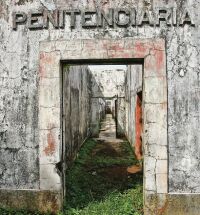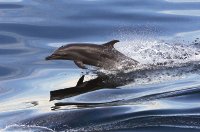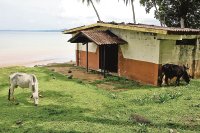| LA PRENSA/David Mesa |
|
|
| Los custodios
y funcionarios civiles de Corrección aquí vivían,
trabajaban, descansaban y esperaban, cada 15 días, que terminara
su turno para ser reemplazados y volver a casa.1056809 |
 |
| locked up:There are still
remnants of Coiba’s past as a prison, but the plan for the island now
is to attract voluntary visitors. |
José
Somarriba Hernández
jsomarriba@prensa.com
history
Coiba, from penal colony
to tourist’s paradise
Although Coiba Island now offers up its
natural beauty
for the benefit of biologists and pleasure-seeking tourists, it wasn’t
so long ago that the island was the site of a notorious penal colony,
where Panama’s criminals, misfits and political dissidents went to live
off the land while serving out their sentence.
Rubén Blades’s song, “The
Cazanguero,” which first
aired in 1975, some 20 years before the colony was abandoned, describes
the hard and cheerless life of the Coiba prisoner.
“Rising early’s the lament of the
cazanguero in Coiba…
Hurry, Chino Juan, they’ve called roll already, and the guard says you
can’t stay behind this time.”
The salsa ballad details how, far from the
mainland,
the “cazangueros,” or convicts, often faced abuse at the hands of
prison guards, their intense homesickness, which was mixed with the
fear that if a guard didn’t mess with you, another inmate would.
Since the colony’s opening in 1919,
prisoners were
transported to Coiba on boats. Former director of Nacional de
Corrección Rosa Cardenas explained that a fleet of barges, known
as
Tango-02, had been donated to the Servicio Marítimo Nacional by
the
U.S. for this purpose.
During World War II, the U.S. Army
requisitioned the barges to serve in combat.
The prisoners’ journey began overland to
Puerto Mutis,
in Veraguas, snaking through the mouth of Río San Pedro until
ending up
in the Gulfo de Montijo. From there, they boarded barges for Coiba, a
trip that in good weather could take eight hours; in rough seas,
upwards of 11 hours.
Escape attempts, of course, also required
a seaworthy
vessel. Over the years, prisoners contrived makeshift boats and rafts
from wood and flotsam held together with barbed wire.
“Some said that Coiba was freedom,” said
Narciso Bastidas, a former inmate. “Which meant they had an escape
plan.”
Prisoners were separated into camps of 30
or 35, which
were set up around La Central, a larger camp where around 120 inmates
lived. Torture by prison guards within the camps was common.
“In the “Machete” camp, there were
vestiges of
torture,” said Luis Lasso, who was the civilian director of the colony
for three years, between 1992 and 1995. “We found holes in the ground
where we learned they’d buried up to their necks rebel members of the
Fuerzas de Defensa, who’d attempted to overthrow General Noriega on
March 16 and October 3, 1989.”
Homosexual prisoners were interned in the
camp known
as Río Amarillo, where they were beaten with hoses or sticks and
forced
to load gravel into large cans and haul them to La Central Catival, a
distance of 5 kilometers.
“How many cans of gravel are there from
here to La Catival?” muses Blades in “The Cazaguero.”
“The gravel, which was found everywhere in
Coiba, was
used to plug holes in the roads, to fill in land or for construction,”
explained Lasso.
Despite being a penal colony, the tropical
island had
its benefits. Lasso described how prisoners concocted moonshine by
fermenting coconut water. Others planted crops, such as rice, yucca and
yams, and herded cattle. Some even found a trade.
An inmate known as Phillip, who served a
30-month
sentence for drug charges, worked as a cook at the residence for civil
servants.
“I knew how to cook from what I’d learned
on the
street, but I perfected my skills on Coiba. I became an expert in
shellfish and cooked cazón [a fish dish] with cream, corn,
lobsters,
prawns, all of which I got straight from the sea,” he said. “When I was
released I felt both joy and sadness, not knowing what was going to
find. But [the experience] had remade my life.”
Since the government converted the island
into a
national park in 2004 following the colony’s closing, tourism in Coiba
has been on the rise. Recently, the Smithsonian Tropical Research
Institute has been collaborating with the park’s management director,
Juan Maté, to develop sustainable tourism plan for the island.
“Traditionally, Parque Nacional de Coiba
has only been
known for the penal colony that was there,” said Maté. “But the
grand
attraction has always been its natural beauty, scenery, and the park's
unique species. We want to revive the historical and cultural heritage,
which is very valuable and that in danger of being lost.”
ANTIDOPAJE COIBEÑO
|
|
| EL EDÉN.
Coiba fue declarada Patrimonio Mundial de la Humanidad por la Unesco,
gracias a la riqueza de su flora y fauna. |
 |
| JUEGO. Las olas
causadas por cualquier embarcación son aprovechadas por los
delfines. En los límites del parque normalmente se aprecian dos
especies: nariz pico de botella y moteados. |
A NEW FACE FOR COIBA
|
|
| LA 12 de octubre.
Era uno de los 23 campamentos que hubo en el penal. Hoy alberga la
estación de la Anam y los seis dormitorios para visitantes.
Allí laboran unos 14 guardaparques que hacen turnos de 15
días. |
 |
| POTRERO sin
límites. El deterioro de las cercas provocó que las
más de dos mil cabezas de ganado, que se cree hay actualmente,
vaguen por la isla sin más barrera que el mar. |
|